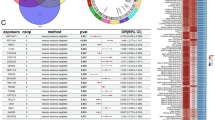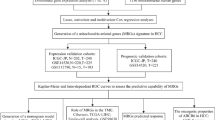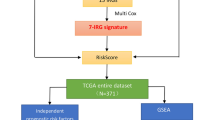Abstract
Acylation modification plays a crucial role in modulating hepatocellular carcinoma (HCC) progression, and their specific prognostic implications in HCC have not been thoroughly investigated. Eleven acylation modifications (crotonylation, lactylation, succinylation, benzoylation, butyrylation, malonylation, glutarylation, 2-hydroxyisobutyrylation, β-hydroxybutyrylation, palmitoylation, myristoylation, and prenylation) were generated consensus cluster. Then, WGCNA was utilized to identify module genes. Finally, machine learning approach was employed to create acylation modification related genes.score (AMRG.score). This analysis revealed two distinct subtypes of AMRG, each characterized by unique molecular signatures. Through the combination of DEGs, DEGs associated with prognosis, and WGCNA, a total of 21 key genes were identified, leading to the creation of AMRG.score. AMRG.score was rigorously validated across independent external cohorts (TCGA-LIHC, LIRI-JP, GSE10143, GSE14520, GSE27150, GSE36376, and GSE76427) and an in-house cohort, demonstrating its reliability and potential applicability. The AMRG.score serves a dual purpose in its application, as it encapsulates essential the clinical context and offers valuable insights regarding the immunotherapy. In particular, patients categorized with a high AMRG.score displayed an active TME and sensitive to immunotherapy. This novel acylation modification-related prognostic signature could effectively assess the prognosis and therapeutic responses of HCC patients, providing new perspectives for individualized treatment for the patient population.
This is a preview of subscription content, access via your institution
Access options
Subscribe to this journal
Receive 6 digital issues and online access to articles
$119.00 per year
only $19.83 per issue
Buy this article
- Purchase on SpringerLink
- Instant access to full article PDF
Prices may be subject to local taxes which are calculated during checkout











Similar content being viewed by others
Data availability
The datasets generated for this study can be found in the GEO database (GSE10143, GSE14520, GSE27150, GSE36376, and GSE76427, GSE91061, GSE78220, Van Allen, and Nathanson; https://www.ncbi.nlm.nih.gov/geo/), and UCSC Xena website (https://gdc.xenahubs.net).
References
Siegel RL, Kratzer TB, Giaquinto AN, Sung H, Jemal A. Cancer statistics, 2025. CA: A Cancer J Clin. 2025;75:10–45.
Brown ZJ, Tsilimigras DI, Ruff SM, Mohseni A, Kamel IR, Cloyd JM, et al. Management of hepatocellular carcinoma: a review. JAMA Surg. 2023;158:410–20.
Vogel A, Meyer T, Sapisochin G, Salem R, Saborowski A. Hepatocellular carcinoma. Lancet (Lond, Engl). 2022;400:1345–62.
Yu SJ. Immunotherapy for hepatocellular carcinoma: Recent advances and future targets. Pharm Ther. 2023;244:108387.
Rimassa L, Finn RS, Sangro B. Combination immunotherapy for hepatocellular carcinoma. J Hepatol. 2023;79:506–15.
Donne R, Lujambio A. The liver cancer immune microenvironment: therapeutic implications for hepatocellular carcinoma. Hepatol (Balt, Md). 2023;77:1773–96.
Ma P, Zou C, Xia S. Oncogenic signaling pathway mediated by Notch pathway-related genes induces immunosuppression and immunotherapy resistance in hepatocellular carcinoma. Immunogenetics. 2022;74:539–57.
Li X, Liu S, Zou L, Dai M, Zhu C. RNA processing modification mediated subtypes illustrate the distinctive features of tumor microenvironment in hepatocellular carcinoma. Genes Immun. 2024;25:132–48.
Shang S, Liu J, Hua F. Protein acylation: mechanisms, biological functions and therapeutic targets. Signal Transduct Target Ther. 2022;7:396.
Jiang G, Li C, Lu M, Lu K, Li H. Protein lysine crotonylation: past, present, perspective. Cell Death Dis. 2021;12:703.
Wan J, Liu H, Chu J, Zhang H. Functions and mechanisms of lysine crotonylation. J Cell Mol Med. 2019;23:7163–9.
Wang S, Mu G, Qiu B, Wang M, Yu Z, Wang W, et al. The function and related diseases of protein crotonylation. Int J Biol Sci. 2021;17:3441–55.
Yu J, Chai P, Xie M, Ge S, Ruan J, Fan X, et al. Histone lactylation drives oncogenesis by facilitating m(6)A reader protein YTHDF2 expression in ocular melanoma. Genome Biol. 2021;22:85.
Liao L, He Y, Li SJ, Yu XM, Liu ZC, Liang YY, et al. Lysine 2-hydroxyisobutyrylation of NAT10 promotes cancer metastasis in an ac4C-dependent manner. Cell Res. 2023;33:355–71.
Shi H, Cui W, Qin Y, Chen L, Yu T, Lv J. A glimpse into novel acylations and their emerging role in regulating cancer metastasis. Cell Mol Life Sci. 2024;81:76.
Nagaraju GP, Dariya B, Kasa P, Peela S, El-Rayes BF. Epigenetics in hepatocellular carcinoma. Semin cancer Biol. 2022;86:622–32.
Hoshida Y, Villanueva A, Kobayashi M, Peix J, Chiang DY, Camargo A, et al. Gene expression in fixed tissues and outcome in hepatocellular carcinoma. N Engl J Med. 2008;359:1995–2004.
Wu B, Liu DA, Guan L, Myint PK, Chin L, Dang H, et al. Stiff matrix induces exosome secretion to promote tumour growth. Nat cell Biol. 2023;25:415–24.
Lim HY, Sohn I, Deng S, Lee J, Jung SH, Mao M, et al. Prediction of disease-free survival in hepatocellular carcinoma by gene expression profiling. Ann Surg Oncol. 2013;20:3747–53.
Grinchuk OV, Yenamandra SP, Iyer R, Singh M, Lee HK, Lim KH, et al. Tumor-adjacent tissue co-expression profile analysis reveals pro-oncogenic ribosomal gene signature for prognosis of resectable hepatocellular carcinoma. Mol Oncol. 2018;12:89–113.
Leek JT, Johnson WE, Parker HS, Jaffe AE, Storey JD. The sva package for removing batch effects and other unwanted variation in high-throughput experiments. Bioinforma (Oxf, Engl). 2012;28:882–3.
Van Allen EM, Miao D, Schilling B, Shukla SA, Blank C, Zimmer L, et al. Genomic correlates of response to CTLA-4 blockade in metastatic melanoma. Sci (N Y, N Y). 2015;350:207–11.
Nathanson T, Ahuja A, Rubinsteyn A, Aksoy BA, Hellmann MD, Miao D, et al. Somatic mutations and neoepitope homology in melanomas treated with CTLA-4 blockade. Cancer Immunol Res. 2017;5:84–91.
Ulloa-Montoya F, Louahed J, Dizier B, Gruselle O, Spiessens B, Lehmann FF, et al. Predictive gene signature in MAGE-A3 antigen-specific cancer immunotherapy. J Clin Oncol: J Am Soc Clin Oncol. 2013;31:2388–95.
Hugo W, Zaretsky JM, Sun L, Song C, Moreno BH, Hu-Lieskovan S, et al. Genomic and transcriptomic features of response to anti-PD-1 therapy in metastatic melanoma. Cell. 2016;165:35–44.
Riaz N, Havel JJ, Makarov V, Desrichard A, Urba WJ, Sims JS, et al. Tumor and microenvironment evolution during immunotherapy with nivolumab. Cell. 2017;171:934–949.e16.
Mariathasan S, Turley SJ, Nickles D, Castiglioni A, Yuen K, Wang Y, et al. TGFβ attenuates tumour response to PD-L1 blockade by contributing to exclusion of T cells. Nature. 2018;554:544–8.
Lu X, Meng J, Zhou Y, Jiang L, Yan F. MOVICS: an R package for multi-omics integration and visualization in cancer subtyping. Bioinforma (Oxf, Engl). 2021;36:5539–41.
Wu T, Hu E, Xu S, Chen M, Guo P, Dai Z, et al. clusterProfiler 4.0: a universal enrichment tool for interpreting omics data. Innov (Camb (Mass)). 2021;2:100141.
Langfelder P, Horvath S. WGCNA: an R package for weighted correlation network analysis. BMC Bioinforma. 2008;9:559.
Zeng D, Ye Z, Shen R, Yu G, Wu J, Xiong Y, et al. IOBR: multi-omics immuno-oncology biological research to decode tumor microenvironment and signatures. Front Immunol. 2021;12:687975.
Maeser D, Gruener RF, Huang RS. OncoPredict: an R package for predicting in vivo or cancer patient drug response and biomarkers from cell line screening data. Brief Bioinform. 2021;22:bbab260.
Oh M, Park S, Kim S, Chae H. Machine learning-based analysis of multi-omics data on the cloud for investigating gene regulations. Brief Bioinforma. 2021;22:66–76.
Ma C, Wu M, Ma S. Analysis of cancer omics data: a selective review of statistical techniques. Brief Bioinform 2022;23:bbab585.
Wu X, Zhou Z, Cao Q, Chen Y, Gong J, Zhang Q, et al. Reprogramming of Treg cells in the inflammatory microenvironment during immunotherapy: a literature review. Front Immunol. 2023;14:1268188.
Bittner S, Hehlgans T, Feuerer M. Engineered Treg cells as putative therapeutics against inflammatory diseases and beyond. Trends Immunol. 2023;44:468–83.
Tanaka A, Sakaguchi S. Regulatory T cells in cancer immunotherapy. Cell Res. 2017;27:109–18.
Savage PA, Klawon DEJ, Miller CH. Regulatory T Cell Development. Annu Rev Immunol. 2020;38:421–53.
Craig AJ, von Felden J, Garcia-Lezana T, Sarcognato S, Villanueva A. Tumour evolution in hepatocellular carcinoma. Nat Rev Gastroenterol Hepatol. 2020;17:139–52.
Oura K, Morishita A, Tani J, Masaki T. Tumor immune microenvironment and immunosuppressive therapy in hepatocellular carcinoma: a review. Int J Mol Sci. 2021;22:5801.
Caja L, Dituri F, Mancarella S, Caballero-Diaz D, Moustakas A, Giannelli G, et al. TGF-β and the tissue microenvironment: relevance in fibrosis and cancer. Int J Mol Sci. 2018;19:1294.
Akkız H. Emerging role of cancer-associated fibroblasts in progression and treatment of hepatocellular carcinoma. Int J Mol Sci. 2023;24:3941.
Wu X, Gu Z, Chen Y, Chen B, Chen W, Weng L, et al. Application of PD-1 blockade in cancer immunotherapy. Comput Struct Biotechnol J. 2019;17:661–74.
Wang Z, Wang Y, Gao P, Ding J. Immune checkpoint inhibitor resistance in hepatocellular carcinoma. Cancer Lett. 2023;555:216038.
Greten TF, Villanueva A, Korangy F, Ruf B, Yarchoan M, Ma L, et al. Biomarkers for immunotherapy of hepatocellular carcinoma. Nat Rev Clin Oncol. 2023;20:780–98.
Funding
This study was supported by the National Natural Science Foundation of China, No. 82203835.
Author information
Authors and Affiliations
Contributions
YL and SB: Conceptualization, Resources. JH and HL: Data curation. CH and JZ: Formal analysis. HQ: Software. YF: Writing—original draft. ZT: Methodology, Visualization. YF and YL: Data curation, Writing—review & editing, Supervision, Investigation. YF: Project administration.
Corresponding author
Ethics declarations
Competing interests
The authors declare no competing interests.
Ethics approval and consent to participate
This study was approved by the Ethics Review Board of the Tongji Hospital, Tongji Medical College, Huazhong University of Science and Technology. All experiments complied with the relevant regulations, and all patients provided written informed consent (TJ-2024-105).
Additional information
Publisher’s note Springer Nature remains neutral with regard to jurisdictional claims in published maps and institutional affiliations.
Supplementary information
Rights and permissions
Springer Nature or its licensor (e.g. a society or other partner) holds exclusive rights to this article under a publishing agreement with the author(s) or other rightsholder(s); author self-archiving of the accepted manuscript version of this article is solely governed by the terms of such publishing agreement and applicable law.
About this article
Cite this article
Li, Y., Bai, S., Hu, J. et al. Post-translational acylation modulates immunosuppression and immunotherapy efficacy in hepatocellular carcinoma. Genes Immun (2025). https://doi.org/10.1038/s41435-025-00362-2
Received:
Revised:
Accepted:
Published:
DOI: https://doi.org/10.1038/s41435-025-00362-2



